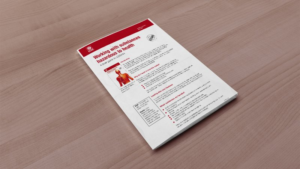Most workplaces contain hazardous substances. These range from everyday cleaning products through to chemicals that require specialist handling and fumes produced by industrial activities. Every year, thousands of workers in the UK become ill because of contact with hazardous substances at their workplace, with lung diseases, cancer and skin complaints among the most common issues. Handling these materials safely is one of the key responsibilities companies have towards their own staff and any visitors or members of the public that could be affected by the use of hazardous substances.
The Control of Substances Hazardous to Health (COSHH) regulations lay out the responsibilities employers have to prevent, reduce or control their workers’ exposure to substances that could harm their health.
Similar legislation has existed for over two decades, but it was introduced in its current form in 2002.
Which Substances are Covered by COSHH?
COSHH covers most chemical or biological substances deemed to be “hazardous to health”. When deciding if a substance is potentially hazardous, it helps to look at the label for any warning signs. For more detailed information, an MSDS (material safety data sheet) might be available from the manufacturer and can provide more detail about a particular substance’s properties and ingredients.
Asbestos, lead, radioactive material and certain types of industrial fumes are covered under their own specialist legislation but aside from these, the majority of hazardous materials are regulated by COSHH.
These include:
– All forms of chemicals and chemical mixtures
– Dusts and fumes created by certain workplace processes
– Gases and vapours
– Germs
– Nanotechnology

What Do Employers Need to Do to Comply with COSHH?
Employers need to know which hazardous substances are in use and what hazards they pose to their workers. They’re required to complete a risk assessment, taking into account all hazards and what could be done to minimise any issues that might arise. They must then ensure this is carried out and all control measures are adequate and in good working order. COSHH risk assessments should be reviewed on a regular basis and again when any new hazardous substances are introduced.
Once the risks have been identified, employers must consider:
– Does the hazardous substance need to be used? Can the process requiring the substance be eliminated or could a safer substance be used instead?
– Which controls do we need to implement? If the hazardous substance in question can’t be eliminated or replaced, the company needs to find other ways to limit exposure and keep their employees safe.
It’s vital that all hazardous substances are stored correctly, preferably in the smallest quantities necessary (larger quantities can be stored off-site). All staff need to be appropriately trained in recognising and handling hazardous materials. It is also the responsibility of the employer to make sure all staff are aware of the risks posed by each hazardous substance.
It might be necessary to make modifications to the working environment where the substances are used. For example, ventilation could be improved or a physical barrier such as a wall could be built to remove the worker from the immediate vicinity of the substance.
– Do we need Personal Protective Equipment (PPE)? PPE is the last line of defence between the hazardous substance and the employees, so it’s a last resort when considering safety measures.
PPE must be of the correct type, well-maintained and readily available for all staff that require it. The company must provide the PPE free of charge.
Why is COSHH important?
In 2018, Tesco were fined £125,000 after a 2016 breach of COSHH and other health and safety legislation at their Highwoods store in Colchester. An employee suffered chemical burns after coming into contact with a corrosive cleaning product. This incident illustrates that all employers need to take COSHH extremely seriously, regardless of their size. The financial penalties for refusing to do so can be severe and, most importantly, the consequences for the health of the employees involved can suffer.
The health issues that can arise from exposure to hazardous substances are varied and can either be immediate or long-term, with some symptoms only surfacing decades after exposure has taken place. Knowledge of COSHH and proper compliance with it is one of the most important duties an employer has towards its workers.


